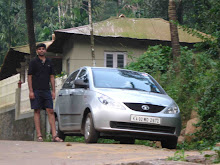The cottage we had booked turned out to be every bit what we had hoped for. Perched precariously on the edge of a precipice, it offered a breathtaking view of the valley along with the Soochipara waterfalls on the slope opposite. Apparently, Soochipara means needlepoint or something like that and that is exactly how it looked from this distance.
 Soochipara waterfalls
Soochipara waterfallsWe sat on the porch, sipping coffee, taking in the sunset and the veil of mist getting ready to enshroud the valley. The Soochipara was gradually becoming hazier. It was as I strained to keep it in sight that I first became aware of the sound, a continuous murmur. Could I hear the waterfall at this distance, I wondered?
“No,” laughed Biju, the cottage keeper. “That’s the Kanthanpara waterfall, very close, would you like to see it?” Would we like to see it! ‘Very close’ was actually correct. What had at first seemed a dangerous precipice (oh, we city-dwellers) actually had a very narrow, very winding path that led to about halfway down the valley. As we peered over rocks and in between trees we could see the swirling waters of the Kanthanpara waterfall.
But that was only a bird’s eye view. To actually get to the waterfall, we had to take a 10 minute drive through hilly roads and hairpin bends.
Kanthanpara Waterfall
Look for information on Kanthanpara and all you’ll find is that it is 8 km from Meppady and 22 km from Kalpetta. And that it is ‘relatively smaller’ than some other waterfalls. What they don’t tell you is how beautiful it is.
 Kanthanpara waterfalls
Kanthanpara waterfallsThe water comes cascading down 99 feet with a mighty roar, rushes down with leaps and bounds, raising spray, to disappear into a valley of dense forest. The sight and sound are inspiring, to say the very least. There are two or three vantage points from where to get the best views of Kanthanpara. One is right at the top, where you can sit on rocks at the very edge of the waterfall and watch the water go by, hear the spray and actually feel the force of the water. There are others at midway and the foot of the waterfall from where you can shoot excellent pictures of the cascade. You can also walk up river for a distance.
 Swirling waters at the Kanthanpara waterfall
Swirling waters at the Kanthanpara waterfallThe best thing about Kanthanpara is that it is not crowded. Maybe it was the time we got there (late evening) but I didn’t spot any avid bathing or swimming or the various aquatic gymnastics and water sports ubiquitous at most waterfall. Just the odd local fisherman, trying his luck before getting home. Also, there was a conspicuous absence of stalls selling everything from straw hats to sneakers.
 The river disappearing into the forest
The river disappearing into the forestAs darkness made its way into the valley, we reluctantly rose to leave. I could have spent an entire day there, but I knew that the rest of our trip was already planned and we had many such sights to take in. So it would just have to be another trip to Wayanad to visit the Kanthanpara waterfall again.













